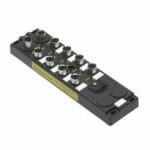Clear understanding of the application, noise sources, and configuration parameters ensures peak variable speed drive (VFD) performance, efficiency, and reliability. VFDs also are known as inverters, ac drives, variable speed drives, or adjustable speed drives. VFD selection is easier with knowledge of loading, overhauling load, noise, and configuration.
A wide variety of variable frequency drives (VFDs) are available, and are sometimes referred to as inverters, ac drives, variable speed drives, or adjustable speed drives. Despite the differences in terminology, these components are all VFDs and control an ac motor’s speed and torque by adjusting the input frequency and voltage to 3-phase ac induction or synchronous motors.
Modern VFDs have made changing the speed of a 3-phase ac motor simple, but it has not always been that way. Even though 3-phase ac induction motors were invented in the late 1880s, for almost 100 years, operating an ac motor at more than one or two speeds was difficult. The number of magnetic poles and an ac motor’s physical construction made a variable speed ac motor drive cost prohibitive, so instead, dc motors were used in variable speed applications.
In the 1980s, VFD technology started becoming less expensive and more reliable. Today, the VFD competes well with traditional dc motor control, but when specifying VFDs, a clear understanding of the application, installation methods, and configuration is critical. Common issues with VFD application, operation, and configuration include:
- Drive selection
- Drive overload
- Drive overvoltage
- Sources of noise
- Electromagnetic interference (EMI)/electromagnetic field (EMF) problems
- Grounding issues
- Incorrect configuration and/or parameter settings.
VFD loading
 The main function of a VFD is varying the speed of a 3-phase ac induction motor. VFDs also provide overload protection, start and stop control, and adjustable acceleration and deceleration. Programmable acceleration and processor-controlled current limiting can reduce motor inrush current at start-up, an important feature for controlling a factory’s maximum instantaneous power load and corresponding peak demand, which is often used by the utility company to set rates or surcharges.
The main function of a VFD is varying the speed of a 3-phase ac induction motor. VFDs also provide overload protection, start and stop control, and adjustable acceleration and deceleration. Programmable acceleration and processor-controlled current limiting can reduce motor inrush current at start-up, an important feature for controlling a factory’s maximum instantaneous power load and corresponding peak demand, which is often used by the utility company to set rates or surcharges.
When specifying a VFD, it’s important to understand the application and select the drive accordingly (see Figure 1). The operating profile of the load must first be considered. With both constant torque applications, such as conveyors (see Figure 2), mixers, and compressors-and variable torque applications, such as pumps, fans, and blowers-careful attention must be paid to overload ratings.
For example, attempting to drive a fan motor faster than its base speed can significantly impact the amount of power required as the fan horsepower varies with the cube of the speed. Running a fan too fast can thus consume excess power and may overload the VFD, while running it at half speed can reduce horsepower requirements by 75% or more, per the affinity laws, which apply to pumps and fans.
Many applications can take advantage of this reduced power consumption at lower speeds to save energy. An example is using a VFD to vary fan speed to match the load, instead of using dampers to reduce airflow from a fan running at full speed.
To avoid the possibility of drive overload, the VFD should be sized based on its maximum current requirements and peak torque demand, as sizing by horsepower alone may not satisfy the maximum demands placed on the motor. Although most VFDs can handle a wide range of horsepower, oversizing is advised when limits are approached.
An oversized motor is less efficient than a properly sized motor, but a VFD helps to minimize this inefficiency, reducing the oversizing penalty to little more than the initial cost for oversizing the drive and motor.



